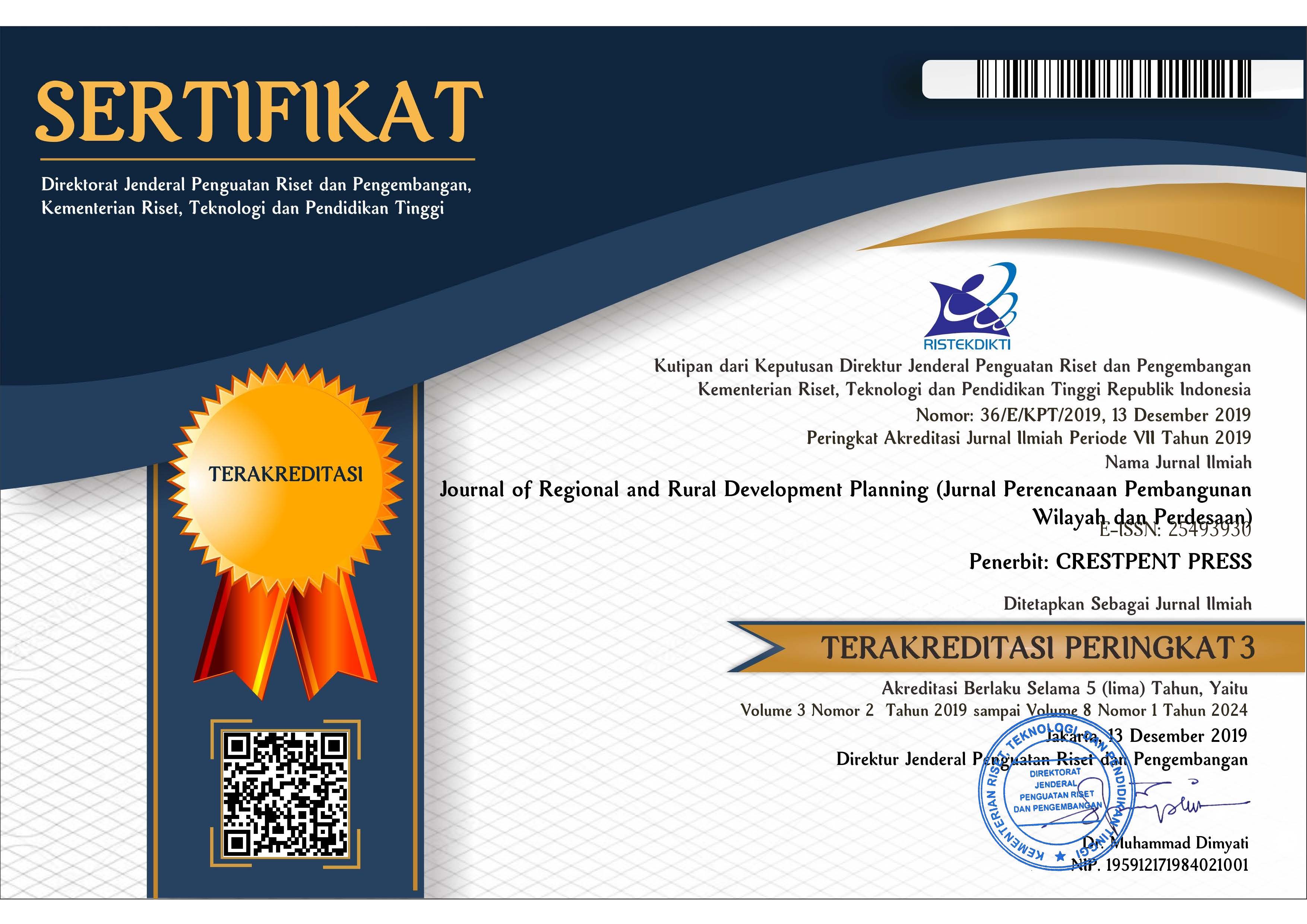Analisis Aktor dalam Perumusan Model Kelembagaan Pengembangan Hutan Rakyat di Kabupaten Bogor
DOI:
https://doi.org/10.29244/jp2wd.2018.2.2.133-150Keywords:
actor, community-forest, content analysis, institutional, Interpretive Structural ModelingAbstract
Bogor regency has an area of 16,945 hectares’ community-forests or 22% of the forest area in the regency. Institutional problems of community-forest management include weak interaction of actors within the organization. Since the organization is part of the institution, its existence becomes an important technical part in securing the operation of the institution. Objectives of this research on analyzing actors and the institution in the community-forest area are: (1) to determine the dominant key actors in community-forests action arena; and (2) to formulate community-forests development institutional models. Qualitative descriptive analysis of actors and institutions employs content analysis. Key actors analysis utilized ISM (Interpretive Structural Modeling) analysis methods. Results of the analysis identified seven key actors in community forest management, namely UPTD BP3K, landowners who lives outside the village, farmer landowners, land tenants, farm labors, lumbermens, and middlemen. Of the seven key actors, four key actors are the most dominant in the community-forest action arena, which are farmer landowners, farm labors, lumbermens and middlemen. There are three models of community-forest management institutions for capacity development actors, namely the institutional model related to venture capital, handling waste of resources, and coordination. This study recommends the necessity to strengthen dominant actors at site level according to the criteria of efficiency, equity, and sustainability. The policy makers need to optimize the capacity and coordination function of government agencies through the institutional coordination model.
References
Adam, Y. O., Pretzsch, J., & Pettenella, D. (2012). Contribution of Non-Timber Forest Products livelihood strategies to rural development in drylands of Sudan: potentials and failures. Agricultural Systems, 117 (C), 90-97. https://doi.org/10.1016%2fj.agsy.2012.12.008
Ashari. (2006). Potensi Lembaga Keuangan Mikro (LKM) dalam Pembangunan Ekonomi Pedesaan dan Kebijakan Pengembangannya, Analisis Kebijakan Pertanian, 4 (2), 146-164.
Caballero, G. (2014). Community-based forest management institutions in the Galician communal forests: a new institutional approach. Forest Policy and Economics, 50 (C), 347-356. https://doi.org/10.1016/j.forpol.2014.07.013
Canadas, M. J., Novais, A., & Marques, M. (2016). Wildfires, forest management and landowners’ collective action: a comparative approach at the local level. Land Use Policy, 56 (2016), 179–188. http://dx.doi.org/10.1016/j.landusepol.2016.04.035
Coleman, E. A. (2009). Institutional factors affecting biophysical outcomes in forest management. Journal of Policy Analysis and Management, 28 (1), 122–146. http://dx.doi.org 10.1002/pam.20405
[Distanhut] Dinas Pertanian dan Kehutanan Kabupaten Bogor. (2014). Laporan Tahunan Pertanian dan Kehutanan. Monografi. Bogor: Distanhut.
Eriyatno. (2003). Ilmu Sistem: Meningkatkan Mutu dan Efektivitas Manajemen (jilid 1). Bogor: IPB Press.
Ethika, D., Purwanto, R. S., Senawi., & Masyhuri. (2014). Peranan petani terhadap strategi pembangunan hutan rakyat di bagian hulu sub das logawa di Kabupaten Banyumas, Jawa Tengah. Jurnal Manusia dan Lingkungan, 21 (3), 377-385.
Hardjanto., Hero, Y., & Trison, S. (2012). Desain kelembagaan usaha hutan rakyat untuk mewujudkan kelestarian hutan dan kelestarian usaha dalam upaya pengentasan kemiskinan masyarakat pedesaan. Jurnal Ilmu Pertanian Indonesia, 17 (2), 103-107.
Hashemnezhad, H. (2015). Qualitative Content Analysis Research: A Review Article. Journal of ELT and Applied Linguistics, 3 (1), 54-62. http://www.jeltal.com/yahoo_site_admin/assets/docs/5.7151855.pdf
Hinings, C., Logue, D., & Zietsma, C. (2017). Fields, governance and institutional infrastructure. SAGE Handbook of Organizational Institutionalism., 2nd Edition. R. Greenwood, C. Oliver, T.B. Lawrence, R. Meyer, Ed. Sage.
Kartodihardjo, H. (2006). Masalah kelembagaan dan arah kebijakan rehabilitasi hutan dan lahan. Jurnal Analisis Kebijakan Kehutanan, 3 (1), 29-41.
Kasper, W., & Streit, M. E. (1998). Institutional Economics: social order and public policy. Cheltenham: Edward Elgar.
Kriyantono, R. (2012). Teknik praktis riset komunikasi, Edisi 6. Jakarta: Kencana Prenada Media Group
Kyfyak, V. (2012). The institutional mechanism of development of the agricultural sector of Ukraine. Ecoforum, 1 (1), 2012
McGinnis, M. D., & Ostrom, E. (2014). Social-ecological system framework: initial changes and continuing challenges. Ecology and Society, 19 (2), 30. http://dx.doi.org/10.5751/ES-06387-190230
Mokhele, M. (2018). The volatility of institutional arrangements that influence development: The case of Bram Fischer International Airport in South Africa. The Journal for Transdisciplinary Research in Southern Africa, 14 (1). https://doi.org/10.4102/td.v14i1.436
North, D. C. (2012). Institutions, Institutional Change and Economic Performance. New York: Cambridge University Press. https://doi.org/10.1017/CBO9780511808678
Okumu, B., & Muchapondwa, E.(2017). Determinants of successful collective management of forest resources: evidence from Kenyan community forest associations. ERSA working paper 698
Osei-Tutu, P., Pregernig,M., & Pokorny, B. (2015). Interactions between formal and informal institutions in community, private and state forest contexts in Ghana. Forest Policy and Economics, 54 (C), 26-35. https://doi.org/10.1016/j.forpol.2015.01.006
Ostrom, E. (2007). Developing a Method for Analyzing Institutional Change. Center for the Study of Institutional Diversity. Arizona: Arizona State University
Ostrom, E. (2008). Doing institutional analysis: digging deeper than markets and hierarchies. Handbook of New Institutional Economics. Menard C, Shirley M., Ed.. Berlin: Springer-Verlag Berlin Heidelberg
Ostrom, E. (2011). Background on the institutional analysis and development framework. Policy Studies Journal, 39 (1), 7-27. http://dx.doi.org/ 10.1111/j.1541-0072.2010.00394.x
Persson, J., &Prowse, M. (2017). Collective action on forest governance: An institutional analysis of the Cambodian community forest system. Forest Policy and Economics, 83 (C), 70-79, https://doi.org/10.1016/j.forpol.2017.06.008
Riduwan. (2009). Pengantar Statistika Sosial. Bandung: Alfabeta
Rout, S. (2011). Collective action for sustainable forestry: institutional dynamics in community management of forest in Orissa. Social Change, 40 (4), 479–502. http://dx.doi.org/10.1177/004908571004000405
Saxena, J. P., Sushil., & Vrat, P. (1992). Hierarchy and classification of program plan elements using interpretive structural modeling. Systems Practice, 5 (6), 651-670. https://doi.org/10.1007/BF01083616
Saxena, J. P., Sushil, & Vrat, P. (2006). Policy and Strategy Formulation: an application of flexible systems methodology. Global Institute of Flexible Systems Management, New Delhi: GIFT Publishing
Setiawan. H., Barus, B., & Suwardi. (2014). Analisis potensi pengembangan hutan rakyat di Kabupaten Lombok Tengah. Majalah Ilmiah Globë, 16 (1), 69-76
Sukisman, S. R. H., & Setiawan, B. (2011). Partisipasi masyarakat anggota koperasi hutan jaya lestari dalam pembangunan hutan rakyat di Kabupaten Konawe Selatan. Majalah Geograf Indonesia, 25 (2), 178 – 197
Sukwika, T. (2016). Evaluasi model kebijakan pengelolaan hutan rakyat berkelanjutan di Kabupaten Bogor [Disertasi]. Bogor (ID): Institut Pertanian Bogor
Sukwika, T., Darusman, D., Kusmana, C., & Nurrochmat, D. R. (2016). Evaluating the level of sustainability of privately managed forest in Bogor, Indonesia. Biodiversitas, 17 (1), 241–248. http://dx.doi.org/10.13057/biodiv/d170135
Sushil. (2012). Interpreting the Interpretive Structural Model. Global Journal of Flexible Systems Management, 13 (2), 87-106. http://dx.doi.org/10.1007/s40171-012-0008-3
Susila, I. (2007). Analisis efisiensi lembaga keuangan mikro. Jurnal Ekonomi Pembangunan, 8 (2), 223-242, https://doi.org/10.23917/jep.v8i2.1043
Suyanto B. (2005). Metode Penelitian Sosial berbagai Alternatif Pendekatan. Jakarta: Prenada
Thompson, R. (2011). Stakeholder Analysis. Winning Support for Your Projects. http://www.mindtools.com/pages/article/newPPM_07.htm
Tiwari, B. K., Tynsong, H., Lynrah, M. M., Lapasam, E., Deb, S., &Sharma, D. (2013). Institutional arrangement and typology of community forests of Meghalaya, Mizoram and Nagaland of North-East India. Journal of Forestry Research, 24 (1), 179–186
Umar, H. (2002). Metode riset komunikasi organisasi. Jakarta: PT. Gramedia Pustaka Utama
Yamane T. (1967). Statistics: An introductory analysis, 2nd Ed. New York: Harper and Row

















.png)




